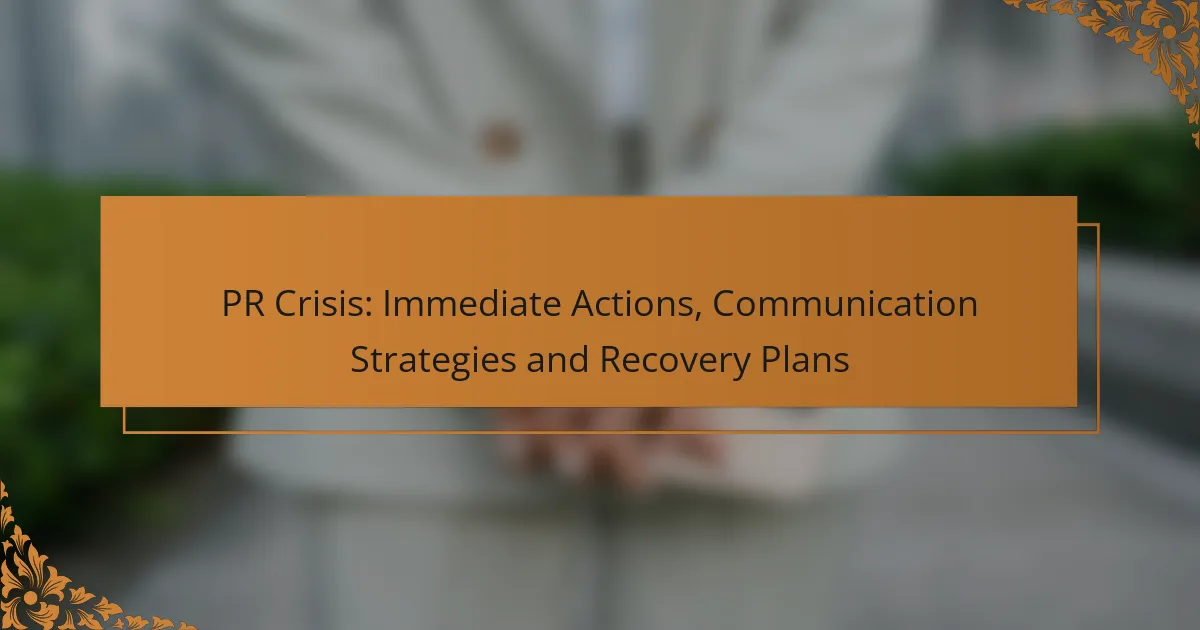In the face of a PR crisis, prompt and effective actions are essential to minimize damage and rebuild trust. This involves assessing the situation, engaging stakeholders, and forming a dedicated crisis management team. Clear and honest communication is vital to address concerns and maintain credibility, while robust recovery plans focus on restoring reputation and strengthening relationships moving forward.
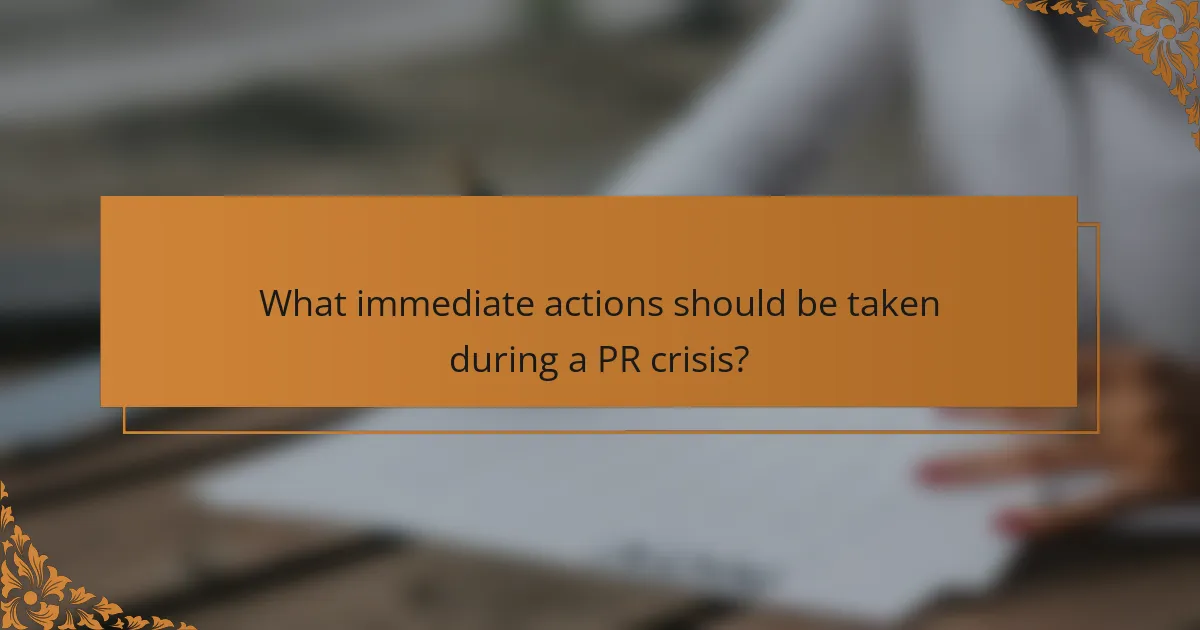
What immediate actions should be taken during a PR crisis?
During a PR crisis, swift and decisive actions are crucial to mitigate damage and restore trust. Key immediate actions include assessing the situation, gathering stakeholders, and establishing a crisis management team.
Assess the situation
Begin by evaluating the nature and scope of the crisis. Identify what has occurred, how it affects your organization, and the potential impact on stakeholders. This assessment should be thorough yet rapid, allowing you to understand the urgency and gravity of the situation.
Consider the source of the crisis, the audience affected, and any legal implications. This will help in crafting appropriate responses and strategies moving forward.
Gather key stakeholders
Bring together essential stakeholders, including executives, legal advisors, and public relations professionals. Their insights and expertise are vital for informed decision-making during a crisis.
Ensure that all relevant parties are on the same page regarding the situation and the steps being taken. This collaboration fosters a unified approach and prevents mixed messages from being communicated externally.
Establish a crisis management team
Create a dedicated crisis management team responsible for overseeing the response. This team should include representatives from various departments such as communications, legal, and operations to ensure a comprehensive strategy.
Assign clear roles and responsibilities to each member to streamline decision-making and communication. Regular meetings should be held to assess progress and adapt strategies as needed.
Develop initial messaging
Craft initial messaging that addresses the crisis directly and transparently. This messaging should acknowledge the issue, express empathy, and outline the steps being taken to address it.
Keep the language clear and concise, avoiding jargon that may confuse the audience. Ensure that the messaging aligns with your organization’s values and maintains credibility.
Monitor media coverage
Actively monitor media coverage and public sentiment regarding the crisis. This includes tracking social media, news articles, and other platforms where your organization is mentioned.
Use this information to gauge public perception and adjust your communication strategy accordingly. Being aware of how the crisis is being portrayed allows for timely responses and corrections if misinformation arises.
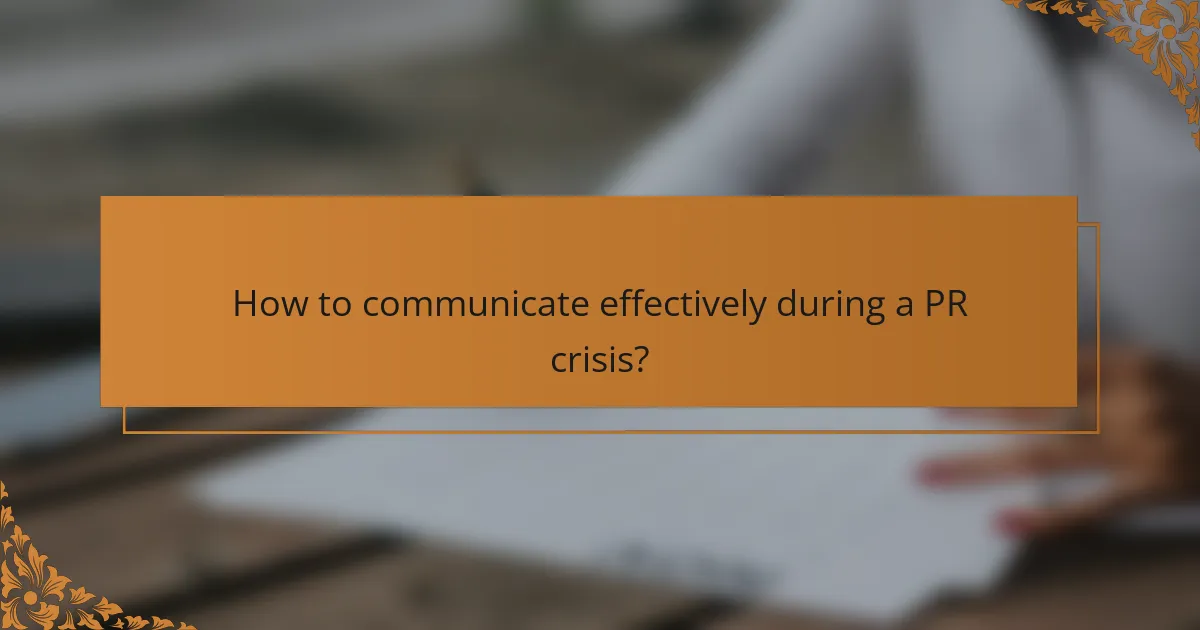
How to communicate effectively during a PR crisis?
Effective communication during a PR crisis is crucial for maintaining trust and credibility. It involves delivering timely, clear, and honest information to stakeholders while addressing their concerns and minimizing potential damage.
Utilize clear and transparent messaging
Clear and transparent messaging is essential in a PR crisis. Use straightforward language to explain the situation, avoiding jargon that may confuse your audience. Ensure that your messaging is consistent across all platforms to prevent misinformation.
For example, if a product recall occurs, clearly state the reasons for the recall, the potential risks, and the steps being taken to resolve the issue. This builds trust and reassures stakeholders that you are taking the matter seriously.
Engage with affected audiences
Engaging with affected audiences is vital for addressing their concerns directly. Listen to feedback through various channels, including emails, social media, and community forums. This two-way communication helps to humanize your brand and shows that you value your audience’s opinions.
Consider hosting Q&A sessions or webinars to provide a platform for stakeholders to voice their concerns and receive immediate responses. This proactive approach can mitigate negative sentiments and foster a sense of community during challenging times.
Leverage social media channels
Social media channels are powerful tools for real-time communication during a PR crisis. Use platforms like Twitter, Facebook, and Instagram to disseminate information quickly and to reach a broad audience. Monitor these channels closely to respond to inquiries and comments promptly.
For instance, if a crisis unfolds, post regular updates on your social media profiles to keep followers informed. Use visuals and infographics to make complex information more digestible and shareable.
Provide regular updates
Regular updates are crucial for keeping stakeholders informed throughout a PR crisis. Establish a schedule for updates, whether daily or weekly, depending on the severity of the situation. Consistency helps to manage expectations and reduces uncertainty.
Consider creating a dedicated webpage or section on your website for crisis updates. This centralizes information and allows stakeholders to find the latest news easily. Always include contact information for further inquiries to ensure transparency and accessibility.
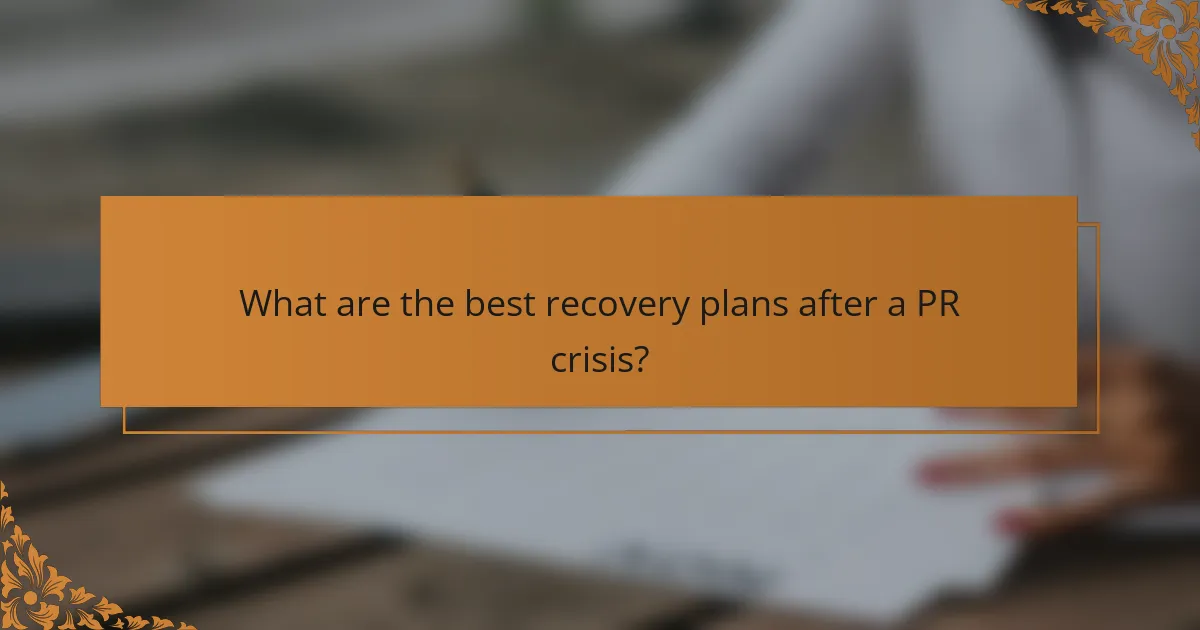
What are the best recovery plans after a PR crisis?
The best recovery plans after a PR crisis focus on restoring the organization’s reputation and rebuilding relationships with stakeholders. These plans typically involve a thorough evaluation of the crisis, implementing corrective actions, and enhancing communication strategies to prevent future issues.
Conduct a post-crisis evaluation
Conducting a post-crisis evaluation is essential for understanding the impact of the crisis and identifying areas for improvement. This involves gathering data on public perception, media coverage, and stakeholder feedback to assess the effectiveness of the initial response.
Consider using surveys or focus groups to collect insights from affected parties. Analyzing this information will help pinpoint weaknesses in your crisis management strategy and inform future planning.
Implement corrective actions
Implementing corrective actions is crucial for addressing the root causes of the crisis and preventing recurrence. This may include revising policies, improving product quality, or enhancing customer service protocols.
Establish a timeline for these actions and communicate updates to stakeholders. Transparency in your efforts can demonstrate commitment to change and help rebuild credibility.
Rebuild public trust
Rebuilding public trust requires consistent and honest communication with your audience. Start by acknowledging the crisis and taking responsibility for any missteps, followed by outlining the steps being taken to rectify the situation.
Engage with your audience through social media, press releases, and community events to foster open dialogue. Consider sharing success stories that highlight positive changes made in response to the crisis.
Enhance crisis communication training
Enhancing crisis communication training for your team is vital for effective response in future situations. Regular training sessions should cover best practices in crisis management, media relations, and stakeholder engagement.
Incorporate simulations and role-playing exercises to prepare your team for real-life scenarios. This proactive approach can significantly improve your organization’s resilience and response time during a crisis.
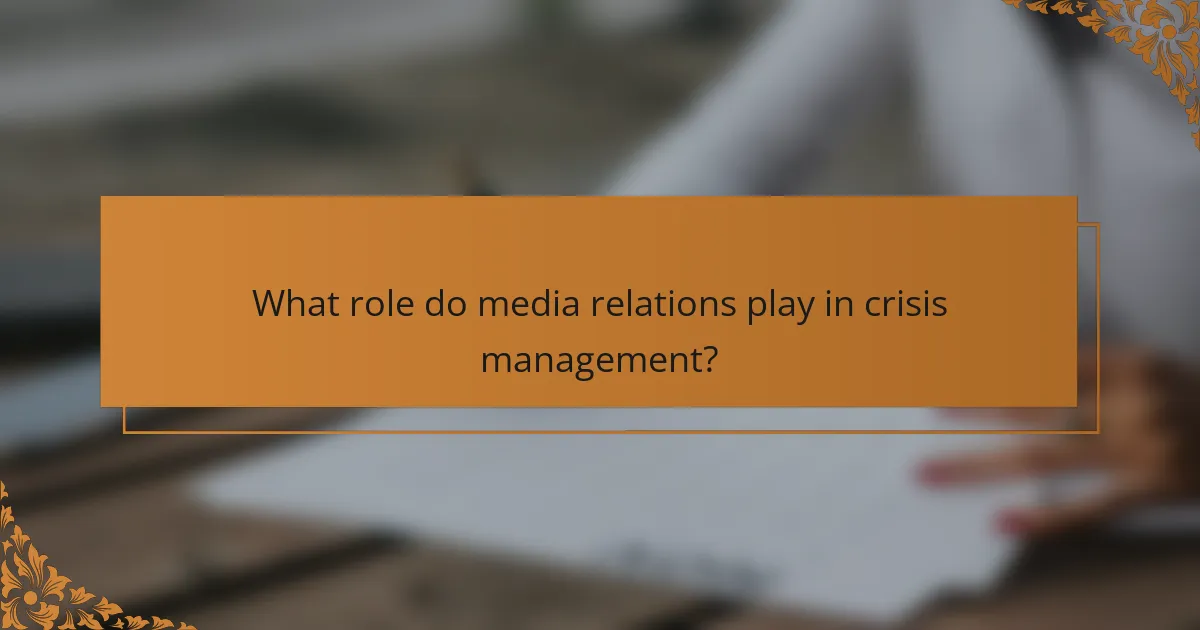
What role do media relations play in crisis management?
Media relations are crucial in crisis management as they help shape public perception and control the narrative during challenging times. Effective communication with journalists can mitigate damage and foster trust with stakeholders.
Establish relationships with journalists
Building strong relationships with journalists before a crisis occurs can significantly enhance your organization’s credibility during a crisis. Regular interactions, such as providing updates and insights, can create a network of supportive media contacts who understand your organization.
Consider hosting informal meet-and-greet events or offering exclusive interviews to key journalists. This proactive approach can lead to more favorable coverage when a crisis arises, as journalists are more likely to trust and report accurately on your organization.
Prepare press releases
Press releases are essential tools for communicating your organization’s response during a crisis. They should be clear, concise, and provide factual information about the situation, your response, and any steps being taken to resolve the issue.
When drafting a press release, include key details such as the nature of the crisis, your organization’s stance, and contact information for follow-up questions. Aim for a tone that is empathetic yet authoritative, and ensure that the release is distributed promptly to maintain control over the narrative.
Manage press conferences
Press conferences can be effective for delivering important updates and addressing media inquiries directly. Organize a press conference when the situation warrants a more personal touch, especially if the crisis has garnered significant media attention.
During the press conference, ensure that key spokespeople are well-prepared to answer questions and convey your organization’s message clearly. Establish ground rules for the event to maintain focus and prevent misinformation from spreading. Consider providing a media kit with relevant information to assist journalists in their reporting.
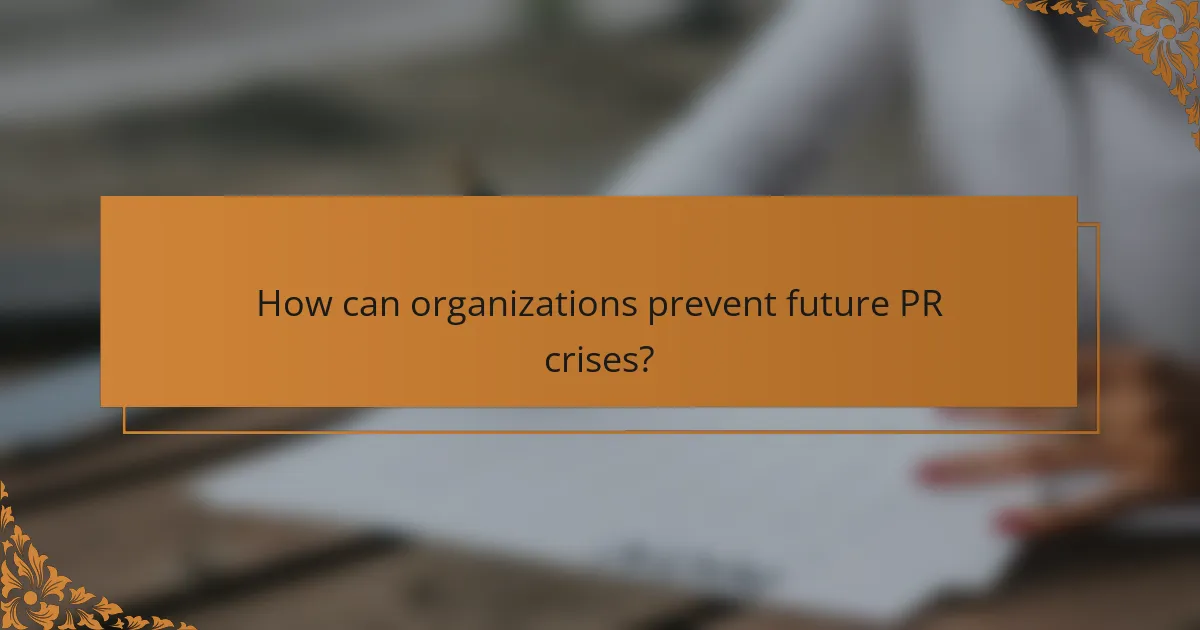
How can organizations prevent future PR crises?
Organizations can prevent future PR crises by establishing robust communication strategies, conducting thorough risk assessments, and actively managing their reputation. These proactive measures help identify potential issues before they escalate and ensure a swift response when necessary.
Develop a crisis communication plan
A crisis communication plan outlines the steps an organization will take in the event of a PR crisis. This plan should include key contacts, communication channels, and predefined messages to ensure consistency and clarity during a crisis.
Regularly review and update the plan to reflect changes in personnel, technology, and industry standards. Conducting drills can also help prepare the team for real-life scenarios, ensuring everyone knows their role and responsibilities.
Conduct regular risk assessments
Regular risk assessments help organizations identify vulnerabilities that could lead to a PR crisis. This process involves analyzing internal and external factors, such as market trends, stakeholder perceptions, and potential legal issues.
Utilize tools like SWOT analysis (Strengths, Weaknesses, Opportunities, Threats) to systematically evaluate risks. Engage with stakeholders to gather insights and ensure a comprehensive understanding of potential threats.
Engage in proactive reputation management
Proactive reputation management involves actively monitoring and shaping public perception of the organization. This can be achieved through consistent messaging, positive media engagement, and community involvement.
Utilize social media and online platforms to share success stories and address concerns promptly. Building strong relationships with journalists and influencers can also help mitigate negative coverage and enhance the organization’s image.
